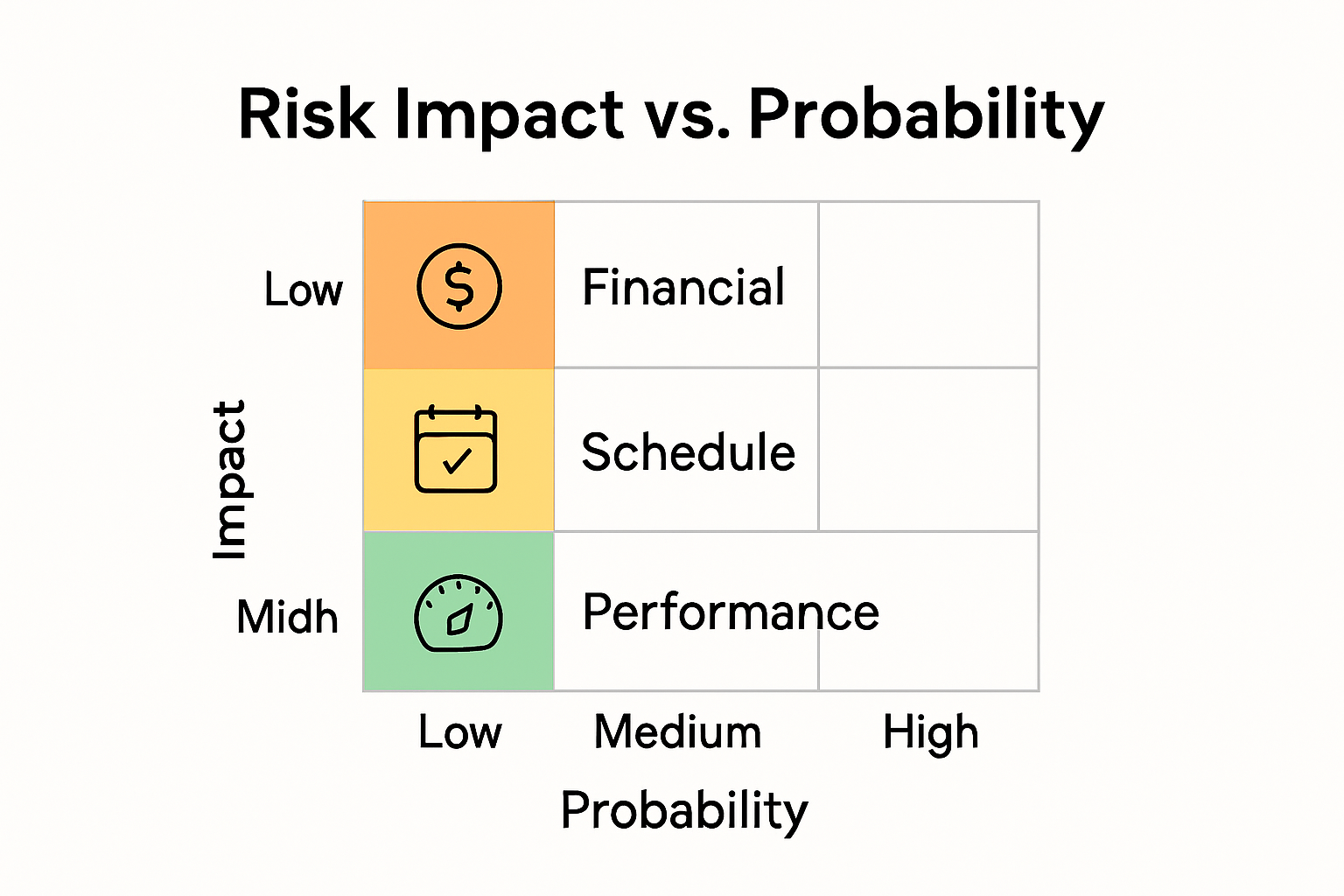Project risk management sounds like a layer of protection for every project timeline and budget. Yet about 70 percent of projects still miss their original goals because of unaddressed risks, according to major industry studies. Most teams scramble to fix issues after they hit, not before they start. The real edge comes when you treat risk less like a checklist and more like your secret advantage.
Table of Contents
- Understanding Project Risks And Their Impact
- Key Steps In Project Risk Management Basics
- Practical Tips For Teams And Leaders
- Common Mistakes And How To Avoid Them
Quick Summary
| Takeaway | Explanation |
|---|---|
| Identify and Assess Risks Early | Conduct thorough risk identification sessions to uncover potential challenges as early as possible. |
| Prioritize Risks by Impact and Probability | Evaluate risks based on their likelihood and potential impact to allocate resources effectively. |
| Build a Risk-Aware Team Culture | Foster an environment where team members feel safe discussing potential risks openly to enhance collaboration. |
| Implement Robust Mitigation Strategies | Develop proactive plans to minimize risks, including contingency planning and risk ownership assignment. |
| Continuously Update Risk Management Processes | Treat risk assessment as an ongoing process by regularly reviewing and adapting strategies to emerging threats. |
Understanding Project Risks and Their Impact
Project risk management is a critical process that helps organizations anticipate, evaluate, and mitigate potential challenges that could disrupt project success. At its core, understanding project risks involves recognizing potential events or conditions that might negatively impact project objectives, timelines, budgets, or overall performance.
The Anatomy of Project Risks
Project risks are not uniform but come in various forms that can significantly influence project outcomes. According to the National Institute of Standards and Technology, project risks can be categorized into technical, operational, strategic, and external threats. Technical risks might involve complex technology implementation, while operational risks could relate to resource allocation or team capabilities. Strategic risks emerge from broader organizational decisions, and external risks stem from factors outside direct project control such as market shifts, regulatory changes, or economic fluctuations.
The U.S. Government Accountability Office emphasizes that early identification and systematic assessment of these risks are fundamental to project management. By creating a comprehensive risk profile, project managers can develop targeted strategies to minimize potential negative impacts and create contingency plans.
Here is a summary table organizing the four main categories of project risks and their typical sources/impacts, helping readers quickly distinguish between them:
Project Risk Categories Summary
| Risk Category | Typical Sources | Example Impacts |
|---|---|---|
| Technical | Technology implementation, system flaws | Delayed deliverables, rework |
| Operational | Resource allocation, team skill gaps | Reduced productivity, missed milestones |
| Strategic | Organizational decisions, business goals | Project misalignment, budget overruns |
| External | Market shifts, regulations, economy | Scope changes, project suspension |
Risk Impact and Probability Assessment

Not all risks are created equal. Project managers must evaluate both the potential impact and likelihood of each identified risk. Some risks might have a high probability but low impact, while others could be rare yet catastrophic if they occur. Probability assessment helps teams prioritize which risks require immediate attention and which can be monitored with less intensive interventions.
Typically, risk impact is measured across several dimensions:
- Financial Impact: Potential monetary losses or budget overruns
- Schedule Disruption: Delays in project milestones or overall timeline
- Performance Degradation: Reduction in project quality or deliverable effectiveness
- Reputation Risk: Potential damage to organizational or project credibility
Effective risk management requires a proactive approach that goes beyond mere identification. Teams must develop robust mitigation strategies, allocate resources for risk management, and maintain flexible response mechanisms. Learn more about tracking project progress and risk mitigation strategies to enhance your project management capabilities.
Successful project risk management is not about eliminating all risks but understanding them thoroughly and creating adaptive strategies that transform potential threats into manageable challenges. By developing a systematic, data-driven approach to risk assessment, organizations can increase project predictability, improve resource allocation, and ultimately enhance overall project success rates.
Key Steps in Project Risk Management Basics
Project risk management is a systematic approach that enables organizations to identify, assess, and mitigate potential challenges before they impact project success. According to the Project Management Institute, effective risk management follows a structured process that transforms uncertainty into a manageable strategic advantage.
Here is a step-by-step table outlining the key stages of project risk management as described in this section, to clarify the process for readers:
Key Steps in Project Risk Management
| Step | Description |
|---|---|
| Risk Identification | Uncovering potential project risks using brainstorming and stakeholder input |
| Risk Assessment | Evaluating risks continuously for threats and opportunities |
| Risk Analysis | Prioritizing risks using qualitative and quantitative methods |
| Response Planning | Developing mitigation, contingency, transfer, or acceptance strategies |
| Risk Monitoring and Updating | Ongoing tracking, updating risk registers, and adapting strategies |
Risk Identification and Assessment
The first critical step in project risk management involves comprehensive risk identification. This process requires project teams to conduct thorough brainstorming sessions, review historical project data, and engage stakeholders to uncover potential risks across multiple dimensions. EDUCAUSE Review emphasizes that risk assessment is not a one-time activity but a continuous process of scanning the project environment for emerging threats and opportunities.
Risk identification typically encompasses several key areas:
- Technical Risks: Potential challenges related to technology implementation
- Operational Risks: Issues surrounding resource allocation and team capabilities
- External Risks: Factors beyond project control such as market changes or regulatory shifts
- Strategic Risks: Broader organizational decisions that might impact project outcomes
Risk Analysis and Response Planning
Once risks are identified, project managers must perform both qualitative and quantitative analysis to prioritize and develop targeted response strategies. The National Academies Press recommends a comprehensive approach that evaluates each risk based on its potential impact and probability of occurrence.
Response planning involves developing specific strategies for each identified risk:
- Mitigation: Proactively reducing the probability or impact of negative risks
- Contingency Planning: Creating backup plans to address potential challenges
- Risk Transfer: Shifting risk responsibility to other parties when appropriate
- Risk Acceptance: Acknowledging risks that cannot be effectively managed
Learn more about tracking project progress and managing potential risks to enhance your project management capabilities.
Successful risk management requires a dynamic and adaptive approach. Project teams must continuously monitor risks, update risk registers, and remain flexible in their response strategies. By implementing a robust risk management framework, organizations can transform potential threats into strategic opportunities, ultimately improving project predictability and increasing the likelihood of successful outcomes.
Practical Tips for Teams and Leaders
Effective project risk management requires more than theoretical knowledge. Teams and leaders must develop practical strategies that transform risk management from a conceptual exercise into a dynamic, actionable process. Microsoft Support emphasizes the importance of creating a proactive risk management culture that empowers team members at all levels.
Building a Risk-Aware Team Culture
Successful risk management starts with cultivating a team environment where identifying and addressing potential challenges becomes second nature. According to Northeastern University’s Knowledge Hub, this involves creating psychological safety where team members feel comfortable openly discussing potential risks without fear of criticism.
Key strategies for building a risk-aware culture include:
- Open Communication: Encourage transparent discussions about potential project challenges
- Regular Risk Reviews: Conduct frequent team meetings dedicated to risk identification
- Collaborative Problem-Solving: Develop collective approaches to risk mitigation
- Continuous Learning: Treat each risk as an opportunity for team growth and improvement
Practical Risk Management Tools and Techniques
RMIT University recommends implementing structured approaches to risk management. Leaders should focus on developing robust risk registers, creating clear escalation protocols, and utilizing technology to track and manage potential project threats.
Practical tools and techniques include:
- Risk Mapping: Visual representations of potential risks and their interconnections
- Scenario Planning: Developing multiple response strategies for different risk scenarios
- Quantitative Risk Assessment: Using data-driven approaches to prioritize risks
- Stakeholder Risk Communication: Creating clear, concise risk reporting mechanisms
Explore strategies for collaborative decision-making to enhance your team’s risk management capabilities.
Ultimately, effective risk management is not about eliminating all risks but developing the organizational agility to respond quickly and strategically. By empowering teams with the right tools, mindset, and communication strategies, leaders can transform potential project threats into opportunities for innovation and growth. The most successful organizations view risk management not as a defensive strategy, but as a proactive approach to driving project success and organizational resilience.
Common Mistakes and How to Avoid Them

Project risk management is fraught with potential pitfalls that can derail even the most well-planned initiatives. The Project Management Institute highlights that understanding and anticipating these common mistakes is crucial for project success.
Misunderstanding Risk Dynamics
One of the most critical errors in project risk management is misinterpreting the nature of risks themselves. Bent Flyvbjerg’s research reveals that project managers often fall victim to behavioral biases that distort risk perception. These biases include optimism bias, where teams underestimate potential challenges and overestimate their ability to manage them.
Common misunderstandings include:
- Confusing Risk Causes and Impacts: Failing to distinguish between the source of a risk and its potential consequences
- Overlooking Opportunity Risks: Focusing solely on negative risks while ignoring potential positive opportunities
- Incomplete Risk Identification: Not conducting comprehensive risk assessments across all project dimensions
- Static Risk Approach: Treating risk management as a one-time activity rather than a continuous process
Systematic Risk Management Failures
The National Academies Press documents significant challenges in organizational risk management, emphasizing the need for a robust and dynamic approach. Many project teams make critical errors that compromise their risk management effectiveness.
Key mistakes to avoid include:
- Inadequate Risk Ownership: Not assigning clear responsibility for specific risk management activities
- Poor Communication: Failing to create transparent risk reporting mechanisms
- Lack of Quantitative Analysis: Relying on subjective assessments instead of data-driven risk evaluation
- Insufficient Contingency Planning: Not developing comprehensive backup strategies for identified risks
Explore effective strategies for collaborative decision-making to enhance your risk management approach.
Successful risk management requires a proactive, adaptive mindset. Organizations must move beyond traditional checklist approaches and develop a culture of continuous risk awareness. This involves creating flexible frameworks that allow for real-time risk assessment, encouraging open communication, and treating risk management as a strategic opportunity rather than a defensive mechanism.
Ultimately, the most effective risk management strategies transform potential threats into opportunities for innovation and improvement. By recognizing common mistakes and implementing systematic approaches to risk identification and mitigation, project teams can significantly increase their chances of success and organizational resilience.
Frequently Asked Questions
What is project risk management?
Project risk management is the process of identifying, assessing, and mitigating potential challenges that could disrupt a project’s success, including its objectives, timelines, and budgets.
How can risks be assessed in project management?
Risks can be assessed through a combination of probability and impact analysis, where project managers evaluate both the likelihood of a risk occurring and the potential impact on the project if it does occur.
What steps are involved in effective project risk management?
Effective project risk management includes key steps such as risk identification, risk assessment, risk analysis, response planning, and continuous monitoring and updating of risk management strategies.
Why is building a risk-aware team culture important?
Building a risk-aware team culture is crucial as it encourages open communication around potential risks, fosters collaboration in problem-solving, and enhances the overall agility of the team to respond to challenges proactively.
Transform Project Risk Management Into Real Results
Identifying risks early and building a proactive team culture can be challenging when your tools slow you down and data gets lost in the noise. If you are tired of missing key risks or struggling with manual tracking, imagine what your team could achieve with an AI-powered platform designed specifically to handle project complexity. Gammatica.com delivers everything you need for successful risk management, including automated task tracking, dynamic checklists, and real-time collaboration. You can empower your team to spot threats early, allocate resources wisely, and track every critical risk—without adding more to your plate. It is time to move from reactive firefighting to confident project delivery.

See for yourself how Gammatica.com helps you:
- Integrate risk mitigation strategies directly into your daily workflows
- Save up to 16 hours per week with AI-driven suggestions and pre-built templates
- Enable seamless communication and real-time updates so nothing slips through the cracks
Ready to strengthen your risk management approach and protect your next project’s success? Discover smarter project control and start simplifying your process today at Gammatica.com. If you want even more practical strategies, check out our guide to project progress tracking and risk mitigation. Take action now and turn your risk management into a competitive advantage.
Recommended
- Project Progress Tracking: Strategies for Success in 2025 | Gammatica
- How to Manage Tasks Effectively in 2025: Proven Strategies for Leaders | Gammatica
- Collaborative Decision Making for Leaders: Strategies for 2025 | Gammatica
- Lead Management for Beginners: 2025 Guide for Teams and Leaders | Gammatica



